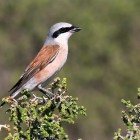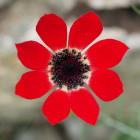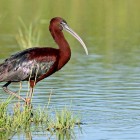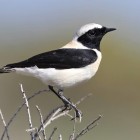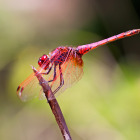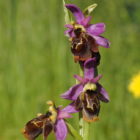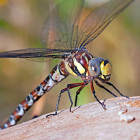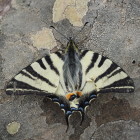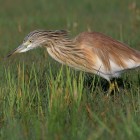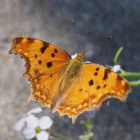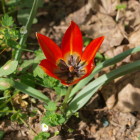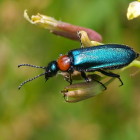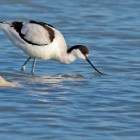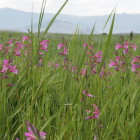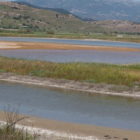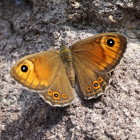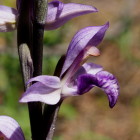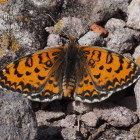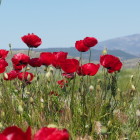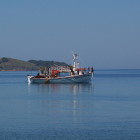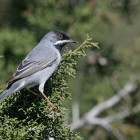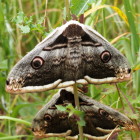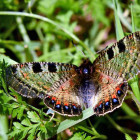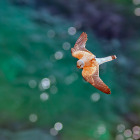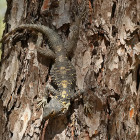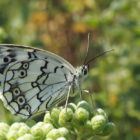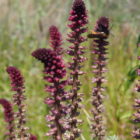Dates & Prices |
BOOK HOLIDAY NOW |
Dates: 25th April – 2nd May 2022 Confirmed departure
Price: £1,295 Fully booked
Single Room Supplement: £130
Deposit: £150 per person
Price Includes: Accommodation, all meals, ground transport, services of guides, holiday report
Not Included: Flights, travel insurance, drinks & other personal items
Conservation Donation: 10% of profits donated to a wildlife charity
Leader(s): Dr Yiannis Christofides
Group Size & Travel: Minimum 4 & maximum 6 guests + 1 leader
Grade: Generally easy walking at a very gentle pace
Holiday Highlights
- Excellent birds during spring migration plus plenty of other wonderful wildlife on one of the most unspoilt of the Greek islands
- Plethora of interesting orchids and Mediterranean wild flower meadows
- Nice selection of early butterflies, dragonflies and reptiles
- Led by our expert botanist, guide & author Dr Yiannis Christofides
- Easy birding with time spent on helping with ID & birdsong
- Wetland and migrant birds at Skalla Kalloni – the epicentre of birdwatching on the island
- Visit the internationally important Petrified forest, one of the many geological features which makes Lesvos a European Geopark
- Unwind at the Malemi Hotel – an ecologically aware and welcoming place in the heart of Lesvos featuring a varied menu
Bird watching during spring migration, plus a wealth of flowers and other wildlife – especially butterflies, dragonflies and reptiles!
A week on the Greek island of Lesvos to enjoy some relaxing & very rewarding birdwatching during spring migration, plus a wealth of other spring Mediterranean flowers and wildlife – especially butterflies, dragonflies and reptiles.
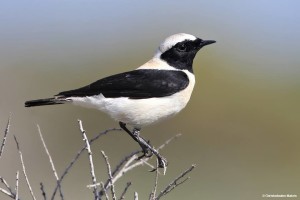
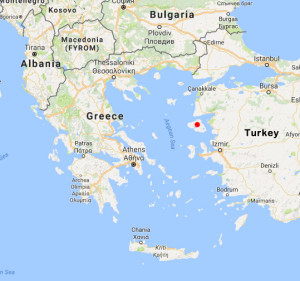
Join us for a leisurely exploration of the beautiful island of Lesvos for its wealth of birds during spring migration and its many other wildlife and geological treasures! We will be taking a deliberately laid back approach and we won’t just be ticking birds off a list, instead we will be taking the time to observe them fully, along with helping guests to identify and learn something about them!
The third-largest Greek Island, Lesvos (known as Mytilene in Greece) is a diverse and geologically very interesting place. Close to the Turkish coastline, it shares many species with the mainland. Aside from having its own impressive list of breeding bird species Lesvos is also located on the main bird migration route north from Africa and with many wetlands it is a magnet for birdlife and a must place to visit in spring!
Some of the local breeding birds we hope to see during our stay include rarer species such as Krüper’s Nuthatch (Sitta krueperi) and Cinereous Bunting (Emberiza cineracea). Breeding birds more common but no less desirable include Western Rock Nuthatch (Sitta neumayer), Lesser Kestrel (Falco naumanni), Long-legged Buzzard (Buteo rufinus), European Bee-eater (Merops apiaster) and Masked Shrike (Lanius nubicus). There is of course the added excitement of new arrivals appearing at almost any time and anywhere as birds from a long list of recorded species pass through on migration north to their breeding grounds. Some may only pause briefly whilst others may stay on for a few days when food is abundant.
We’ll be staying at Hotel Malemi, which has been catering for bird watching and natural history orientated guests for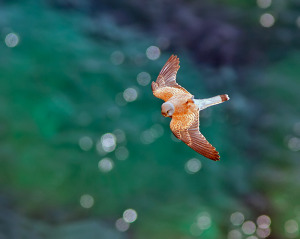 many years. That and the fact that it is ideally located at the heart of the island and within walking distance of the Kalloni wetlands, makes it the perfect place! The wetlands are rightly famous as the best area for birds on the island and we’ll be visiting them several times during our stay. The marshes at Gulf of Kalloni offer a magnificent show of birds, along with plenty of wild flowers, dragonflies and butterflies to enjoy too.
many years. That and the fact that it is ideally located at the heart of the island and within walking distance of the Kalloni wetlands, makes it the perfect place! The wetlands are rightly famous as the best area for birds on the island and we’ll be visiting them several times during our stay. The marshes at Gulf of Kalloni offer a magnificent show of birds, along with plenty of wild flowers, dragonflies and butterflies to enjoy too.
Surprisingly, for a dry Mediterranean island, Lesvos boasts a large list of dragonflies, due largely to the coastal wetland habitats. Some special dragonflies on the wing in April include Odalisque (Epallage fatima), Eastern Spectre (Lestes macrostigma), along with the common Violet Dropwing (Trithemis annulata) and many species of Orthetrum.
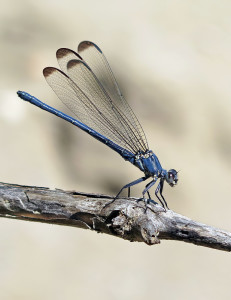
Lesvos also boasts one of the largest butterfly lists in the Greek islands. We should catch up with some lovely species that are on the wing in April, such as Black-veined White (Aporia crataegi), Long-tailed Blue (Lampides boeticus), Green Hairstreak (Callophrys rubi), Scarce Swallowtail (Iphiclides podalirius), Eastern Festoon (Zerynthia cerisy) and Cleopatra (Gonepteryx cleopatra). We might be lucky enough to find the magnificent False Apollo (Archon apollinus), an early spring jewel, which could still be on the wing depending on how the season develops.
During our holiday we will also venture further afield to visit several parts of the island to explore some different habitats for the bird life, interesting plants and orchids, other wildlife, geology and culture. This includes the petrified Forest in the west of the island, which is the largest in the world and the museum there has a superb exhibit of fossils.
We will also spend time looking at the wonderful Ophrys of which there are plenty on the island. We will look at not only their beauty but delineating the differences between the closely related species. The south of the island and the ancient olive groves offer a different habitat with many orchids, drifts of anemones in all colours and other plants. The Olympos range offers yet a different experience with many orchids, tulips, anemones and other botanical treats!
If you would like to enjoy the best of a Greek island spring then this holiday is most certainly going to be perfect for you!
- Red-backed Shrike
- Anemone pavonina
- Limonos monastery
- Glossy Ibis
- Ophrys lesbis
Day 1: Arrival in Mytilene and transfer to hotel in Skala Kalloni. After we settle in we shall make a short excursion to the nearby wetlands.
Days 2, 4 & 7: Kalloni wetlands & Achladeri woodland. We shall explore the wetlands, salt marshes and rivers around Skala Kalloni, where we hope to see a range of resident and migrant birds, including Purple and Night Herons, Common, Curlew, Green and Marsh Sandpipers, Black-winged Stilts, Kentish and Little Ringed Plover, Glossy ibis, Little and Spotted Crakes. Bee-eaters should be going through now, and White and Dalmatian pelicans are possible.
We shall also visit Achladeri, a woodland area to look for Krüper’s Nuthatch, Short-toed Tree-creeper, Masked Shrike, Wood lark and Black-eared Wheatear, which all breed here. An amazing stand of Limodorum abortivum also is to be seen here.
Day 3: Sigri and the Petrified Forest. We head west for Lesvos remarkable petrified forest. However we stop en-route to look for another of Lesvos specialities, Ophrys lesbis and many typical Mediterranean spring flowers such as Lathyrus clymenum. We shall reach the barren, volcanic landscape and walk through the Petrified Forest, looking at the amazing remains but also keeping a close eye for possible migrant birds.
On the way back we shall visit Ipsilou Monastery, one of the top bird migrant areas on the island. Warblers and flycatchers make land fall here, and the top is a great place to watch passing swifts and raptors. Breeding birds include Rock Sparrow, Cinereous Bunting, Isabelline Wheatear, Sombre Tit and Chukar Partridge. It also holds a library of ancient documents, some of which we may able to view.
Day 5: South west of the island. Today we head to the south-west again, but following a different route along the coast, stopping for wild flowers and birds. We shall end up at the beach at Chrysos, an area with dry volcanic rocks and a variety of habitats which host Isabelline and Black-eared Wheatears, Rufous-tailed Scrub Robin, Cretzschmar’s Bunting, and Western Rock Nuthatch. The area is also good for migrating raptors such as Eleonora’s Falcon, Lesser Kestrel, Long-legged Buzzard and Short-toed Eagle. Reptiles also abound in the dry phrygana with Snake-eyed Lizard, Starred Agama, Montpellier and Dahl’s Whip Snakes possible.
Day 6: Mount Olympos. An exciting day today as we head for Mount Olympos, stopping on our way to search the olive groves for orchids and other plants such as Aristolochia hirta with its extraordinary flowers, and also the food plant for the Eastern Festoon which should be on the wing, together with another remarkable butterfly, the False Apollo, Archon apollinus, only found in the eastern Aegean islands, North Greece & Turkey. The latter flies until the mid-April, and may be seen in a late season. Other butterflies expected at this time of the year are Cleopatra, Large Wall, Eastern Baton blue and Green-underside blue. The meadows should be full of bright red Anemone pavonina, Anemone coronaria in many colours and many orchids including Orchis italica, Ophrys minutula, Ophrys homeri, Serapias parviflora and Ophrys sicula. Higher up, under ancient Chestnut woods we shall find Orchis provincialis, Orchis tridentata and Tulipa hageri. This is also the habitat of Fritillaria pontica, flowering towards the end of April. We also hope to see Ophrys reinholdii, a very rare orchid on Lesvos.
Day 8: Departure day. We start on our return journey to Mytilene, and if time allows we shall stop at the Gulf of Gera to visit the fields there, home to thousands of Orchis laxiflora . If in time for lunch we shall stop at the nearby taverna for a fish meze.
- Ophrys lesbis
- Eastern Black-eared Wheatear
- Violet Dropwing
- Ophrys homeri
- Eastern Spectre
- Scarce Swallowtail
- Squacco Heron
- Tulipa hageri
- Alosimus syriacus
- Anemone pavonina
- Avocet
- Chukar
- Gladiolus illyricus
- Kaloni wetlands
- Glossy Ibis
- Large Wall Brown
- Lathyrus clymenum
- Limodorum abortivum
- Limonos monastery
- Melitaea trivia
- Ophrys homeri
- Orchis laxiflora
- Lesvos scenery
- Lesvos scenery
- Papaver argemone
- Red-backed Shrike
- Rüppell’s Warbler
- Saturnia pyri
- False Apollo
- Lesser Kestrel
- Starred Agama
- Melanargia larissa
- Tulipa hageri
- Lysmachia atropurpurea
- Limodorum abortivum
New holiday so testimonials will follow later
New holiday so reports will follow later


